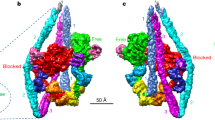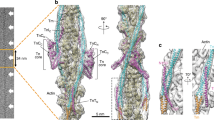Abstract
THE tropomyosin molecule consists of two α helices, which form a coiled-coil a little over 400 Å long1. Besides forming crystals, tropomyosin can be precipitated with divalent cations to produce needle shaped aggregates (showing a variety of patterns of cross striations in the electron microscope2) for which the detailed molecular packings have not been established. At low resolution, however, the α helices may be regarded as smooth rods. The structure of such aggregates could depend, to some extent, on considerations of closest packing of the rods. This possibility seems to have been first considered by Rudall3 in his discussion of the crystal structure of the α protein from Mantis egg case, where he showed that double helices may be close-packed to form sheets by staggering each double helix by one quarter of the pitch with respect to the next. I report here that the idea of a quarter stagger between tropomyosin molecules, in conjunction with certain electron microscope results, leads to a value for the pitch of the tropomyosin helix.
This is a preview of subscription content, access via your institution
Access options
Subscribe to this journal
Receive 51 print issues and online access
$199.00 per year
only $3.90 per issue
Buy this article
- Purchase on Springer Link
- Instant access to full article PDF
Prices may be subject to local taxes which are calculated during checkout
Similar content being viewed by others
References
Cohen, C., Caspar, D. L. D., Parry, D. A. D., and Lucas, R. M., Cold Spring Harb. Symp. quant. Biol., 36, 205–216 (1971).
Caspar, D. L. D., Cohen, C., and Longley, W., J. molec. Biol., 41, 87–107 (1969).
Rudall, K. M., Lectures on the Scientific Basis of Medicine, V., 217–230 (Athlone Press, London, 1956).
Cohen, C., and Longley, W., Science, 152, 794–796 (1966).
Parry, D. A. D., and Squire, J. M., J. molec. Biol., 75, 33–55 (1973).
Huxley, H. E., Cold Spring Harb. Symp. quant. Biol., 37, 361–376 (1972).
Parry, D. A. D., Biochem. biophys. Res. Commun., 57, 216–224 (1974).
Hodges, R. S., Sodek, J., Smillie, L. B., and Jurasek, L., Cold Spring Harb. Symp. quant. Biol., 37, 299–310 (1972).
Author information
Authors and Affiliations
Rights and permissions
About this article
Cite this article
LONGLEY, W. The double helix of tropomyosin. Nature 253, 126–127 (1975). https://doi.org/10.1038/253126a0
Received:
Revised:
Issue Date:
DOI: https://doi.org/10.1038/253126a0
This article is cited by
-
Fourteen actin-binding sites on tropomyosin?
Nature (1975)
-
Tropomyosin and actin
Nature (1975)
-
Double helix of tropomyosin
Nature (1975)
Comments
By submitting a comment you agree to abide by our Terms and Community Guidelines. If you find something abusive or that does not comply with our terms or guidelines please flag it as inappropriate.



